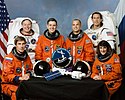STS-88
| STS-88 | |
|---|---|
 | |
| Údaje o expedici | |
| Na stanici | ISS |
| Loď | Endeavour |
| COSPAR | 1998-069A |
| Členů expedice | 6 |
| Počet výstupů do vesmíru | 3 |
| Délka výstupů do vesmíru | 21 hodin a 22 minut |
| Datum startu | 4. prosince 1998 8:35 UTC |
| Kosmodrom | Kennedyho vesmírné středisko, Florida, USA |
| Vzletová rampa | 39A |
| Spojení se stanicí | 7. prosince 2:07 UTC |
| Délka letu | 11 dní, 19 hodin, 19 minut |
| z toho na stanici | 6 dnů, 18 hodina, 17 minut |
| Odlet ze stanice | 13. prosince 20:24 UTC |
| Datum přistání | 15. prosince 1998 10:53 UTC |
| Místo přistání | Kennedyho vesmírné středisko |
| Parametry dráhy | |
| Perigeum | 388 km |
| Apogeum | 401 km |
| Doba oběhu | 92,4 minut |
| Sklon dráhy | 51,6° |
| Fotografie posádky | |
 | |
| Zleva Ross, Cabana, Sturckow, Newmann, Krikaljov, Currieová | |
| Navigace | |
Předchozí STS-95 Následující STS-96 | |
STS-88 byla mise amerického raketoplánu Endeavour k Mezinárodní vesmírné stanici. Cílem letu byla doprava amerického modulu Unity k Mezinárodní vesmírné stanici. Uskutečnily se tři výstupy do otevřeného vesmíru.
Posádka
 Robert D. Cabana (4), velitel
Robert D. Cabana (4), velitel Frederick W. Sturckow (1), pilot
Frederick W. Sturckow (1), pilot Nancy J. Currieová (3), letový specialista 1
Nancy J. Currieová (3), letový specialista 1 Jerry L. Ross (6), letový specialista 2
Jerry L. Ross (6), letový specialista 2 James H. Newman, Ph.D (3), letový specialista 3
James H. Newman, Ph.D (3), letový specialista 3 Sergej K. Krikaljov (4), letový specialista 4, Roskosmos (RKK Eněrgija)
Sergej K. Krikaljov (4), letový specialista 4, Roskosmos (RKK Eněrgija)
V závorkách je uvedený dosavadní počet letů do vesmíru včetně této mise.
Výstupy do vesmíru (EVA)

- EVA 1: 7. prosinec, 1998 – 7 h, 21 m (Ross, Newman)
- EVA 2: 9. prosinec, 1998 – 7 h, 02 m (Ross, Newman)
- EVA 3: 12. prosinec, 1998 – 6 h, 59 m (Ross, Newman)
Reference
V tomto článku byl použit překlad textu z článku STS-88 na slovenské Wikipedii.
Externí odkazy
 Obrázky, zvuky či videa k tématu STS-88 na Wikimedia Commons
Obrázky, zvuky či videa k tématu STS-88 na Wikimedia Commons
Média použitá na této stránce
Designed by the crew members, this patch commemorates the first assembly flight to carry United States-built hardware for constructing the International Space Station (ISS). This flight's primary task is to assemble the cornerstone of the Space Station: the Node with the Functional Cargo Block (fgb). The rising sun symbolizes the dawning of a new era of international cooperation in space and the beginning of a new program: the International Space Station. The Earth scene outlines the countries of the Station Partners: the United States, Russia, those of the European Space Agency (ESA), Japan, and Canada. Along with the Pressurized Mating Adapters (PMA) and the Functional Cargo Block, the Node is shown in the final mated configuration while berthed to the Space Shuttle during the STS-88/2A mission. The Big Dipper Constellation points the way to the North Star, a guiding light for pioneers and explorers for generations. In the words of the crew, "These stars symbolize the efforts of everyone, including all the countries involved in the design and construction of the International Space Station, guiding us into the future."
The U.S.-built Unity connecting module (right) and the Russian-built Zarya module are backdropped against the blackness of space in this 70mm photograph taken from the Space Shuttle Endeavour. After devoting the major portion of its mission time to various tasks to ready the two docked modules for their International Space Station (ISS) roles, the six-member STS-88 crew released the tandem and performed a fly-around survey of the hardware.
STS088(S)002 (November 1998):
Five NASA astronauts and a Russian cosmonaut assigned to the STS-88 mission, scheduled for an early December launch, take time out from their busy training agenda for a crew portrait. Seated in front are Sergei K. Krikalev, a mission specialist representing the Russian Space Agency (RSA), and astronaut Nancy J. Currie, mission specialist. In the rear, from the left, are astronauts Jerry L. Ross, mission specialist; Robert D. Cabana, mission commander; Frederick W. Sturckow, pilot; and James H. Newman, mission specialist.



